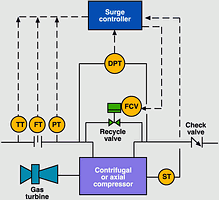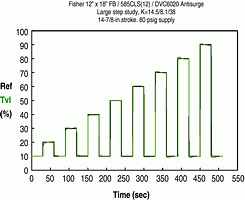

Many industries rely on large compressors for their operation, either axial or centrifugal in design. These units constitute a significant capital investment for the company.
The latest technology is employed to give maximum efficiency from the compressor and turbine drive and also to protect the compressor from failure during a plant upset condition.
When looking at compressors the biggest concern is the potential for surge conditions. It is sensible, therefore, to look at how the surge condition occurs prior to looking at the means to combat its effects.
The compressor turns at the required speed to maintain the required downstream pressure for plant requirements. If there is a sudden decrease in plant demand then there will be a downstream pressure spike causing a sudden increase in head across the compressor. If the pressure spike is high enough then it is possible to achieve a flow reversal in the compressor. This bleed back will cause a loss of pressure on the downstream side of the compressor causing the load to pick up in the forward flow direction.
Surging of the compressor can lead to catastrophic failure after only a short period of time. In addition to the possibility of failure surge conditions can upset operations, alter the internal compressor clearances and overstress the compressor seals. Should the seals need to be replaced due to this overstressing there is not only a large maintenance cost but also the high cost of plant downtime that is also incurred.
To prevent the system from experiencing a surge event there are two possible methods that can be applied.
1. The speed of the compressor could be varied to stop the compressor from reaching the surge point as the flow varies. This is not an efficient way of running a compressor and also speed reduction may not be achieved quick enough to catch the surge.
2. The second, and most favoured method is to install an efficient anti-surge system. This is fast acting and consists of an anti-surge valve, controller and various other additional accessories.
Figure 1 shows a typical anti-surge control schematic. The surge controller takes into account the temperature (TT), flow (FT) and pressure (PT) upstream of the compressor, the head across the compressor (DPT) and the compressor speed (ST). Other variables may be included depending on the constituency of the gas. The surge controller will operate as close to the surge line as possible to maximise the efficiency of the compressor and turbine without jeopardising the performance of the compressor. The use of high quality surge controllers, anti-surge valves and additional accessories will allow for operation closer to the surge point, hence, improving the operational efficiency.

In the event of a potential surge condition, the anti-surge controller will send a signal to the anti-surge valve (FCV) to open to the required set point to pass a given amount of flow back to the suction side of the compressor. Depending on the process upset, this may be a small opening or full stroke. For full stroke operation this must be achieved in less than two seconds. Failure to achieve this speed of operation can expose the compressor to additional surges.
In the process of trying to achieve these fast operating speeds dynamic performance of the valve at low valve openings is often compromised. The last five years has brought dramatic improvements in anti-surge control valve and system design. The following text will highlight some of these enhancements.
Valve body design
The standard balanced control valve has small balancing holes. During fast opening the air trapped above the plug has to pass through these holes causing a resistance to upward movement. The plug on the larger size valves has now been redesigned, by using spokes, to reduce this resistance. As high flow rates cause axial and radial thrusts, an extra piston ring has been supplied at the lower end of the plug to reduce these effects.
Repeated axial plug motion can also lead to downstream pressure pulsations leading to excessive piping vibration. The extra piston ring also assists in reducing clearance flow, which may affect controllability at very low flows.
Valve noise
Due to the high flow rates experienced in large anti-surge valves in conjunction with high differential pressures across the unit, excessive sound pressure levels (SPL) are generally experienced if special noise attenuating trims, such as the WhisperFlo, are not utilised in the unit.
The WhisperFlo is a latest development from Fisher Controls and combines velocity control with frequency shifting (Figure 2) to achieve SPL reductions up to 40 dBA (this is 10 dBA more attenuation than the traditional drill hole cage technology) when used in severe service applications.

These high SPL figures may not be of concern environmentally as the compressor is generally generating a higher SPL than the valve, however, excessive valve SPL may damage the valve itself and also lead to stress fatigue in the adjacent pipework.
Actuation
Due to the fast stroking requirements of anti-surge valves, actuators and accessories were often selected purely on the basis of achieving full stroke as quickly as possible. Such selection may cause unacceptable overshoot when partial stroke is required during the surge condition.
In the past the use of electro-hydraulic actuation for anti-surge applications was pursued. These actuators gave fast stroking and accurate positioning. The problem with this option is that, over a period of time, not only was it found that a large capital investment was required for the initial installation, but high maintenance costs made this selection unattractive.
Advancements in pneumatic technology have led to pneumatic actuation becoming the prevalent choice for anti-surge applications. On smaller systems, spring return piston/diaphragm actuators may be used and are normally designed to fail open on loss of air pressure.
On larger systems, valves often require large actuator forces in conjunction with long strokes. The most common type of actuator used in this case is the double acting piston type which then requires a trip valve and volume tank option to achieve the required air fail action.
Where large actuators are installed, full stroking of the valve may cause severe damage to the actuator as the piston reaches the limit of its travel. This could also lead to unwanted vibration in the downstream pipework. To this end, piston actuators are often supplied with air brakes within the cylinder that will rapidly decelerate the piston in the last 3-5% of its travel.
Air cushioning
When using piston type actuators in anti-surge applications it is important to review the frictional effects that can occur in the unit. Attention to detail such as chrome plating the internals of the cylinder and using a piston with a wear band will reduce frictional effects and eliminate galling respectively.
Accessories
The common approach to obtain fast stroking is to incorporate volume boosters into the system. The booster amplifies the air volume enabling the valve to attain required stroking speed. In order for the boosters to operate properly, the air on the other side of the piston must be exhausted quickly. Quick exhaust valves have met this need in the past.
Quick exhaust valve volume booster
Quick exhaust valves are on/off devices and small differential pressures can quickly switch the device and give rapid opening of the valve. Due to their extreme sensitivity, bypasses are often installed around the unit to this.
Although quick exhaust valves have been applied to low-pressure spring and diaphragm type actuators as well as high-pressure piston actuators, they can cause severe overshoots that are difficult to tune out. Therefore, in anti-surge applications, care should be taken in the selection and use of these devices especially where large volume actuators are being used and large overshoots cannot be tolerated. Instead, for these applications, dynamic performance objectives should be achieved using multiple boosters. Multiple booster selection will also lead to easier tuning of the valve and minimise the need for repeated tuning that may be required using quick exhaust valves.
Tuning and control
The control valve positioner holds the greatest potential to improve actuator control and response time. In the past, it was common for spool type positioners with fast response to be used in these applications because of their ability to respond quickly to step changes, however, these devices often require constant 'tweaking' and do not allow the user to monitor the performance of the valve.
As the performance of smart transmitters has improved, so has their ability to be used to facilitate tuning on the valve and the ability to predict potential problems before they occur. This has been brought about by improvements in the positioner gain settings and in performance monitoring systems.
The smart positioner recommended for this application is a high gain, proportional plus derivative controller that has three adjustments - forward path gain, minor-loop feedback gain and velocity feedback gain.
The forward path gain is used to set the speed of response where a higher gain value yields a faster response. The velocity feedback gain controls the secondary damping, which is used to attenuate slight overshoots in the response. The minor-feedback controls the primary damping and is used to reduce the cycling in the response and allow higher forward path gains to be used.
Figure 3 shows the step response performance test for a 30" valve with a 24" stroke beginning with 10% step change up to 70%. It should be noted that the higher gain settings allow the valve to react quickly to the step response change with minimal overshoot. The valve met the stroke time requirements and also improved the ability to attain accurate closed loop control.

The correct selection of positioning devices in conjunction with applicable accessories can dramatically reduce dead time whilst increasing accuracy of stem position and linearity.
With traditional anti-surge systems, using combinations of volume boosters and quick exhaust valves, it can take an experienced technician many hours to properly tune a single valve. The elimination of quick exhaust valves in conjunction with the use of smart positioner technology can reduce this operation to 30 minutes.
Conclusions
The proper selection of anti-surge valves relies on more than just meeting noise and stroking speed requirements. Elimination of the potential for damaging vibration in the system is normally the bigger concern and goes beyond just selecting a low noise trim. Advances have been made in overall trim selection that provides better control whilst eliminating the potential for axial and radial vibration.
Meeting stroking speed requirements is the first part of the puzzle. Ensuring that the valve can perform well in closed loop control completes the picture. The elimination of quick exhaust valves goes a long way to achieving this. The use of smart positioners also ensures that gains can be increased whilst preventing excessive overshoot in the system.
By looking at the latest technologies in valve and actuator designs, whilst coupling this with smart positioner technology and good accessory selection, optimal performance from an anti-surge system can be achieved.
This material was presented by Pete Underhill of Alpret Control Specialists to SAIMC Johannesburg branch at its June 2005 meeting.
| Tel: | +27 11 249 6700 |
| Email: | [email protected] |
| www: | www.acs-autocon.com |
| Articles: | More information and articles about Automation Control Solutions |

© Technews Publishing (Pty) Ltd | All Rights Reserved